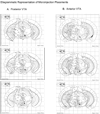Site-specific microinjection of baclofen into the anterior ventral tegmental area reduces binge-like ethanol intake in male C57BL/6J mice
- PMID: 19485562
- PMCID: PMC2732108
- DOI: 10.1037/a0015345
Site-specific microinjection of baclofen into the anterior ventral tegmental area reduces binge-like ethanol intake in male C57BL/6J mice
Abstract
The GABAB agonist baclofen has been shown to alter ethanol intake in human and animal studies (E. M. Moore et al., 2007). GABA-subB receptors are located within the ventral tegmental area (VTA; A. Imperato & G. DiChiara, 1986) and therefore may be involved in modulating voluntary ethanol intake. The present study assessed the effects of baclofen in a variation on a new mouse model of binge-like ethanol intake that takes advantage of the nocturnal nature of this species (J. S. Rhodes, K. Best, J. K. Belknap, D. A. Finn, & J. C. Crabbe, 2005; J. S. Rhodes et al., 2007). Baclofen or saline was microinjected into the anterior or posterior VTA of male C57BL/6J mice. Immediately afterward, mice were presented with ethanol, water, or sugar water using the Drinking in the Dark model, a procedure of fluid administration for 2 hr, 3 hr into the dark cycle). Fluid intake was recorded at 30, 60, 90, and 120 min; retro-orbital sinus bloods were sampled upon termination of the 120-min ethanol access period. Baclofen reduced binge-like ethanol intake when microinjected into the anterior VTA, whereas posterior VTA microinjections did not alter ethanol intake. Baclofen had no effect on water or sugar water intake when administered to anterior or posterior VTA. These results add to the growing literature suggesting that GABA-subB receptor systems are important in the modulation of binge-like ethanol intake and suggest that the GABA-subB receptor system may have different roles in anterior versus posterior VTA.
Copyright (c) 2009 APA, all rights reserved.
Figures








Similar articles
-
GABAA receptors in the posterior, but not anterior, ventral tegmental area mediate Ro15-4513-induced attenuation of binge-like ethanol consumption in C57BL/6J female mice.Behav Brain Res. 2011 Jun 20;220(1):230-7. doi: 10.1016/j.bbr.2011.02.014. Epub 2011 Feb 12. Behav Brain Res. 2011. PMID: 21320533 Free PMC article.
-
Agonism of the endocannabinoid system modulates binge-like alcohol intake in male C57BL/6J mice: involvement of the posterior ventral tegmental area.Neuroscience. 2009 Dec 1;164(2):424-34. doi: 10.1016/j.neuroscience.2009.08.007. Epub 2009 Aug 7. Neuroscience. 2009. PMID: 19665522 Free PMC article.
-
Microinjection of baclofen and CGP7930 into the ventral tegmental area suppresses alcohol self-administration in alcohol-preferring rats.Neuropharmacology. 2018 Jul 1;136(Pt A):146-158. doi: 10.1016/j.neuropharm.2017.10.012. Epub 2017 Oct 16. Neuropharmacology. 2018. PMID: 29050951
-
"Drinking in the dark" (DID) procedures: a model of binge-like ethanol drinking in non-dependent mice.Alcohol. 2014 May;48(3):235-41. doi: 10.1016/j.alcohol.2013.08.005. Epub 2013 Oct 29. Alcohol. 2014. PMID: 24275142 Free PMC article. Review.
-
Role of GABA(B) receptor in alcohol dependence: reducing effect of baclofen on alcohol intake and alcohol motivational properties in rats and amelioration of alcohol withdrawal syndrome and alcohol craving in human alcoholics.Neurotox Res. 2004;6(5):403-14. doi: 10.1007/BF03033315. Neurotox Res. 2004. PMID: 15545024 Review.
Cited by
-
GABAB receptor ligands for the treatment of alcohol use disorder: preclinical and clinical evidence.Front Neurosci. 2014 Jun 6;8:140. doi: 10.3389/fnins.2014.00140. eCollection 2014. Front Neurosci. 2014. PMID: 24936171 Free PMC article. Review.
-
Increased behavioral responses to ethanol in Lmo3 knockout mice.Genes Brain Behav. 2014 Nov;13(8):777-83. doi: 10.1111/gbb.12176. Epub 2014 Sep 24. Genes Brain Behav. 2014. PMID: 25176312 Free PMC article.
-
Rodent models and mechanisms of voluntary binge-like ethanol consumption: Examples, opportunities, and strategies for preclinical research.Prog Neuropsychopharmacol Biol Psychiatry. 2016 Feb 4;65:297-308. doi: 10.1016/j.pnpbp.2015.05.012. Epub 2015 Jun 2. Prog Neuropsychopharmacol Biol Psychiatry. 2016. PMID: 26021391 Free PMC article. Review.
-
Regulator of G protein signaling 6 is a critical mediator of both reward-related behavioral and pathological responses to alcohol.Proc Natl Acad Sci U S A. 2015 Feb 17;112(7):E786-95. doi: 10.1073/pnas.1418795112. Epub 2015 Feb 2. Proc Natl Acad Sci U S A. 2015. PMID: 25646431 Free PMC article.
-
Suppressing Effect of Baclofen on Multiple Alcohol-Related Behaviors in Laboratory Animals.Front Psychiatry. 2018 Sep 28;9:475. doi: 10.3389/fpsyt.2018.00475. eCollection 2018. Front Psychiatry. 2018. PMID: 30323777 Free PMC article. Review.
References
-
- Anstrom KK, Cromwell HC, Markowski T, Woodward DJ. Effect of baclofen on alcohol and sucrose self-administration in rats. Alcohol Clin Exp Res. 2003;27:900–908. - PubMed
-
- Besheer J, Lepoutre V, Hodge CW. GABAB receptor agonists reduce operant ethanol self-administration and enhance ethanol sedation in C57BL/6J mice. Psychopharmacology (Berl,) 2004;74:358–366. - PubMed
-
- Boehm SL, II, Piercy MM, Bergstrom HC, Phillips TJ. Ventral tegmental area region governs GABAB receptor modulation of ethanol-stimulated activity in mice. Neuroscience. 2002;115(1):185–200. - PubMed
-
- Brodie MS, Appel SB. Dopaminergic neurons in the ventral tegmental area of C57BL/6J and DBA/2J mice differ in sensitivity to ethanol excitation. Alcohol Clin Exp Res. 2000;24(7):1120–1124. - PubMed
-
- Colombo G, Agabio R, Carai MAM, Lobina C, Pani M, Reali R, Addolorato G, Gessa GL. Ability of baclofen in reducing alcohol intake and withdrawal severity: I-preclinical evidence. Alcohol Clin Exp Res. 2000;24:58–66. - PubMed

